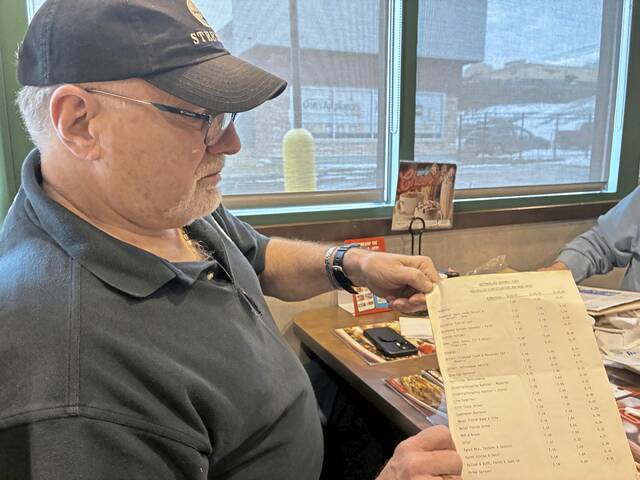A month after a jury awarded the largest judgment ever assessed in a Westmoreland County civil trial, questions remain about just who will pay the $19 million verdict rendered last month against Washington Township homeowners over life-changing injuries sustained when a family friend dove onto a raft in their swimming pool nearly nine years ago.
Just who will pay is still to be determined, according to legal and insurance experts.
“An appeals process can take another one to two years,” Latrobe attorney Ned Nakles said.
Michael Fraser, a then- 21-year-old from Vandergrift, broke his neck and sustained other injuries when he dove into an in-ground swimming pool at the home of Robert and Laura O’Black during a holiday party on July 6, 2013. Witnesses said Fraser jumped off a diving board and onto the raft and was propelled into the water, where he struck his head in an area between the deep and shallow ends of the pool.
Fraser broke his neck and suffered other injuries that left him wheelchair-bound and paralyzed from the waist down.
Fraser’s lawyers argued during the trial that the O’Blacks covered a warning that appeared on the raft that advised against using it for diving and that it was not suitable to be used in pools.
The raft was never produced into evidence. It was discarded years ago, according to lawyers for Fraser and the O’Blacks.
The O’Blacks argued Fraser acted irresponsibly when he dove into the pool and it was his actions alone that caused his injuries.
Because jurors found Fraser to be 30% responsible for his injuries, lawyers asked Westmoreland County Common Pleas Judge Harry Smail Jr. to lower the verdict to $13.3 million. That reduced amount, if approved by the judge, is still expected to be far beyond the limits of the O’Blacks’ homeowners insurance policy.
“Insurance companies only have to pay up to a policy limit,” said Stuart Setcavage, a former litigation manager at State Farm Insurance in Pittsburgh who now consults with lawyers in cases that involve insurance companies and claims. “(Legal judgments) just don’t go away, and policy holders may have to file for bankruptcy.”
Richard Cassidy, president of Kattan-Ferretti Insurance in Greensburg, said be believes the average homeowner with a swimming pool in this region carries an insurance policy that limits liability payouts to just $1 million.
That means a homeowner is required to pay out of pocket any additional judgment rendered by the courts.
Cassidy said word of the $19 million jury verdict spread quickly among his clients.
“The day of the verdict, we were getting calls for clients asking if they have enough protection,” Cassidy said.
For the O’Blacks, the decision to fight the case in court was made by their insurance company, lawyers said. According to court filings, no offer was made to Fraser to settle his claim against the O’Blacks.
“It’s industry standard that once liability for payment under terms of the policy becomes reasonably clear, an insurance company is required to make a good faith attempt for settlement. Generally, insurance companies make some attempt to get it settled,” Setcavage said.
Nakles said an insurance company’s decision to take a case to trial typically comes with an unwritten obligation to pay off a judgment if they lose in court.
“There’s an old saying that if you try it you buy it,” Nakles said.
Nakles declined to speculate how and when the verdict might be paid off in the Fraser-O’Black lawsuit but said that, in many cases, the loser in high-dollar litigation files their own lawsuit against their insurance carrier to pay the judgment in what is called a bad faith allegation.
Defendants, such as the O’Blacks can sue to force their insurance company to pay the full judgment.
“Sometimes people who win at trial go to the defendants and ask they assign them that claim to go after an insurance company themselves,” Nakles said.
Mike Calder, the lawyer who represented Fraser at trial, declined to discuss the case citing the ongoing appeal filed late last month in which the O’Blacks claimed errors were made by Smail during the trial and that the verdict should be overturned.
Calder wants the judge to impose another nearly $4 million in delayed damages because the O’Blacks and their insurance company never made an offer to settle the case before trial.
In court documents filed last week, the O’Blacks’ lawyer, Robert Loch, conceded no settlement offer was tendered but argued delayed damages don’t apply in this case because it was likely the verdict would be overturned on appeal. Loch also said that should delayed damages be authorized by the judge, the amount sought by Fraser should be lowered to an additional $1.37 million to account for trial delays caused by the coronavirus pandemic and other procedural issues.
“The verdict itself should be overturned, and any amount of delayed damages would be improper,” Loch wrote.








